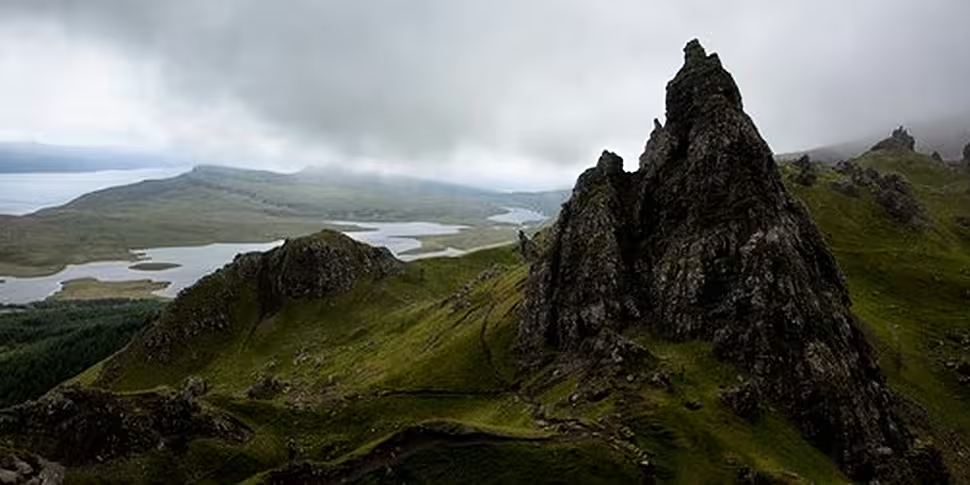The Isle of Skye, or an t-Eilean Sgiathanach from the Old Norse for ‘Cloud Island’ in reference to the often mist-enshrouded Cuillin Hills.
To the locals it’s Eileen a’Cheo, the Isle of Mist.
Skye is the second largest of Scotland’s islands, the best known of the Inner Hebrides a 50-mile-long patchwork of velvet moors, jagged mountains, sparkling lochs, and towering sea cliffs. It’s one of the world’s best - at least according to National Geographic, which voted Skye the fourth best in the world.
The island is popular with tourists, lagging only behind Edinburgh and Loch Ness as the top destinations in Scotland. The hordes tend to stick to Portree, Dunvegan and Trotternish - it’s almost always possible to find peace in the further-flung corners.
Rain gear is essential for when the mists close in, but for those lacking, there are plenty of castles, crofting museums, pubs and restaurants, along with dozens of art galleries and craft studios. For those prepared for the elements, be warned: the Atlantic gales and near-monsoon rains offer a dank and mysterious personality to this remote and windswept isle.
When the damp weather blanket is pulled back to reveal the sky, Skye takes on a magical and almost ethereal quality, showcasing its sharp cliff landfalls, shingle beaches, and islands known as skerries.
Sky first was ruled by the Norse kingdoms, before a long period of domination by Clan MacLeod & Donald. In the 18th century, Jacobite risings let to the breaking of the clan system and the subsequent ‘clearances’ - entire communities replaces with sheep farms, some of which also involved forced emigrations to distant lands. Since 1995, Skye has been connected to the mainland by a bridge, which helps beat life into the island’s industries: tourism, agriculture, fishing, and whisky distilling.
What to see:
Trotternish and the north east part of the Island
This peninsula can be toured in a day from Portree. The full circuit, when done anti-clockwise, gives a better view of the Old man of Storr, a rock formation on Trotternish Ridge, overlooking the Sound of Raasay, wind-sculpted rock pinnacles towering above the water. It’s a lunar landscape, 50m high, a pot-bellied beast of crumbling basalt. It was first scaled by an English mountaineer in 1955, a feat only repeated a handful of times since then. If you pick up a permit in Portree, you can fish for brown trout.

The Old Man of Storr [Pixabay]
Mealt Waterfall and Kilt Rock
If you head 22km north, you can see this beautiful waterfall, which drops 100m into the sea - though the loch water gets blown away before it actually reaches the sea. This gives you a great view of Kilt Rock, where columns of dolerite form what looks like pleats in the cliff. A nearby visit worth making is the Fossil Museum at Ellishader - a huge dinosaur bone was found in the area in 1996, and dinosaur footprints were found at Saffin Beach in 2002.

Mealt Waterfall [Tumblr/Visittheworld]
Opened in Kilmuir in 1965 to completely preserve the township of thatched cottages depicting the conditions and lifestyle of 19th century crofters. On view are an old family home, the village smithy, the weaver’s house, as well as a vast array of crofting tools, displays and equipment.
There are also pictorial and historical archives, including the story of Flora MacDonald, who famously disguised Bonnie Prince Charlie as a spinning maid and smuggled him to safety. A track leads to the cemetery where she is buried - supposedly draped in a sheet the prince once slept in. The spot is not from from where she first landed with the Young Pretender disguised as her maid as he tried to flee to France.
The only distillery left on the island is in the central parts of Skye, in Minginish. Set on the shores of Loch Harport, with its dramatic views of the Cuillins. The whisky is alluring and sweet, a full-bodied single malt. The tour is £7 and lasts 45 minutes, while weekdays there’s also a full tasting tour - though it will set you back £30.
Where to stay:
Halfway between Dunvegan and Waterstein, this is a superb romantic retreat combining a gourmet restaurant in a candlelit crofter’s cottage - with sumptuous five-star rooms (double £345) in the modern house next door. Book well in advance, but bear in mind - no kids allowed.
It is known as a great food destination, and the tasting menu was marvellous: langoustines (on miniature crisp tattie scones); crab risotto coral roe under crust of hazelnut; cold and hot smoked fish; tiny whelks pickled overwhelmingly, fresh ingredients were treated imaginatively. Oysters; trout roe, venison with rhubarb; the classic hot marmalade pudding souffled. A superb kedgeree with peat smoked salmon for breakfast.

The Three Chimneys [DiscoverScotland.com]
One of the world’s ‘Top 25 Small Hotels’ according to Condé Naste Traveller, the lodge is located at the foot of Kinloch Hill, on the shores of the sea loch Na Dal in Sleat.
This was once the Highland home of Clan MacDonald, owned by the high chief and steeped in heritage and history. It’s still a seat of power and influence - Lord MacDonald lives there, along with his wife Claire, a cookery writer.
The rooms have views of the loch or hills and all are scattered with antique pieces and prints and artwork. Old MacDonalds of generations long-since past get an eyeful of every diner.
How to get there:
Fly from Dublin to Inverness, and then either take the bus or the daily service operated by Scotrail. But there’s a spectacular drive from Inverness along Lough Ness, or north via Polkton & Lough Carron.









